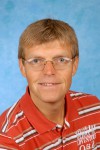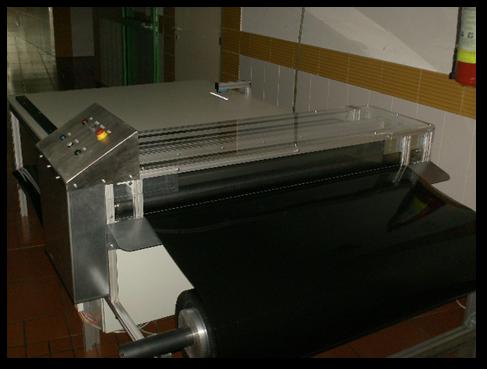2009/2010
Schneidanlage für Pelletstankverkleidungen
Jahrgang
Projektpartner
Arcus Ariola Peilstein
Maturanten

Mahringer Gerald
5BAT

Pirklbauer Christoph
5BAT
Betreuer

Stockinger Thomas

Kaufmann Gerhard

Starlinger Josef
Problemstellung
Die Behindertenwerkstädte Arcus Ariola in Peilstein fertigt Pelletstanksverkleidungen für Ökofen an. Die derzeitige Maschine ist für diese Anwendung nicht geeignet. Es handelt sich dabei um eine Schlagschere für Blechplatten. Da es sich bei den Verkleidungen aber um Kunststoffplatten handelt ist es schwierig diese zu schneiden und es wird viel Kraft benötigt um die Hebel zu betätigen. Außerdem ist die Rolle auf dem das Rohmaterial aufgewickelt ist nicht zentrisch gelagert sondern liegt nur auf einer Welle auf. Die HTBLA Neufelden bekam daher den Auftrag eine neue Maschine zu entwickeln die eine schnelle und einfache Fertigung ermöglicht.
Zielsetzung
Es soll eine neue Maschine zur Steigerung der Produktion und zur Erfüllung der Kundenwünsche entwickelt werden. Dabei gilt es folgende Punkte zu beachten:
· Automatisches Einziehen des Rohmaterials auf die gewünschte Länge.
· Automatischer Schnitt.
· Behindertengerechte Bedienung der Maschine.
· Entwicklungskosten unter 2000 €.
Wichtig in diesem Zusammenhang ist auch:
· Möglichst leise Fertigung
· Keine Spanentstehung
· Schneller Einzug und Schnitt um die Fertigungsdauer pro Platte zu reduzieren.
Projektablauf
· Entwicklung mehrerer Konzepte wie die Ziele umgesetzt werden könnten
· Schneidversuche um die benötigten Kräfte zu erfassen
· Zeichnen des Konzeptes mit Catia in 3D
· Fertigen der Teile in der schuleigenen Werkstätte
· Zusammenbau der Maschine
· Programmieren des SPS-Programmes in der Programmiersprache FUP (Funktionsplan)
· Verkabeln des Schaltschranks und des Bedienpults
· Funktion der Maschine testen und eventuell Verbesserungen vornehmen
Systembeschreibung
Der Schnitt erfolgt mit einem Rundmesser das auf einem Schlitten gespannt ist. Der Schlitten läuft auf einer selbstgebauten Linearachse die mit einem Gleichstrommotor angetrieben ist. Das Material wird mit 2 Stahlrohren die als Walzen dienen eingezogen die ebenfalls von einem Gleichstrommotor angetrieben werden. Die Länge der Kunststoffplatte wird mit einer Lichtschranke gesteuert. Durch Verschieben der Lichtschranke wird die Länge der Platte bestimmt (falls dies notwendig ist).
Presentation of the problem
The workshop for handicapped people Arcus Ariola in Peilstein produces coverings for pellets tanks for Ökofen. The recent machine is not suited for this task because it is a manual machine for cutting sheet metal. Much force is required to pull the handle and it is quite tiring for the worker. Furthermore the coil is not bedded centrically but only is placed on a much smaller axle. Because of this reasons the HTBLA Neufelden got the order to develop a new machine which could cope with these tasks better than the old one.
Objectives
The task is to develop a new machine which raises the production rate and also fulfills the customers’ requirements. The following points have to be considered to complete this order:
· Automated pulling in of the raw material to the desired length.
· Automated cutting of the material.
· A handling which is suited for the disabled workers.
· The development costs should stay below 2000€.
Furthermore important in this context is that:
· the machine should be quiet.
· there shouldn’t be any chippings.
· Fast pulling in and cutting in order to reduce the production time per plate.
Project schedule
· Development of multiple concepts which can solve the tasks.
· Cutting tests in order to gain information about the required cutting force.
· Construction of the concept with Catia in 3D.
· Production of the parts in the school’s workshop.
· Assembling the machine.
· Programming the PLC-Program with the programming language FUP (function plan).
· Wiring the control panel and the control box
· Testing the machine and making improvements
Description
The cutting of the plastic plate (PE) is done by a circular knife which is attached to a sleigh which runs on a self built linear axis which is driven by a dc motor. The raw-material is pulled in by two steel pipes which are pressed together. These steel pipes are also driven by a dc motor. The length of the plate is controlled by a light barrier.


